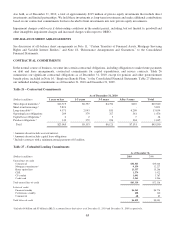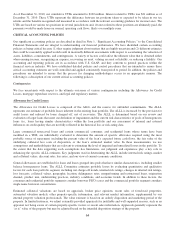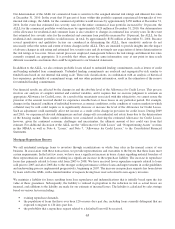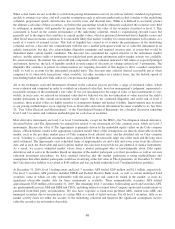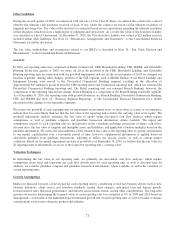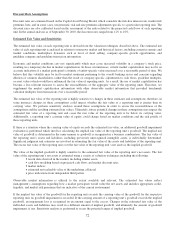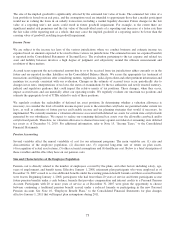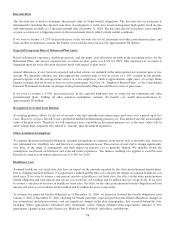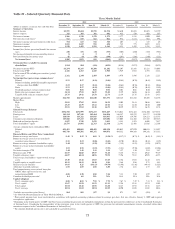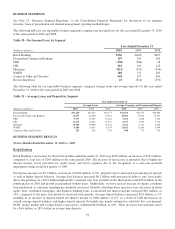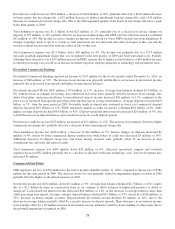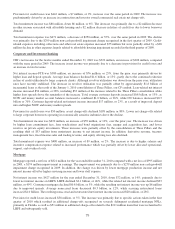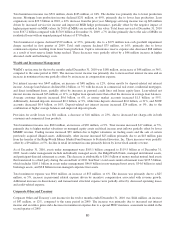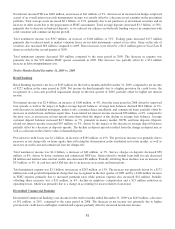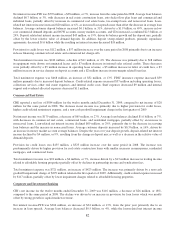SunTrust 2010 Annual Report Download - page 88
Download and view the complete annual report
Please find page 88 of the 2010 SunTrust annual report below. You can navigate through the pages in the report by either clicking on the pages listed below, or by using the keyword search tool below to find specific information within the annual report.
Discount Rate Assumptions
Discount rates are estimated based on the Capital Asset Pricing Model, which considers the risk-free interest rate, market risk
premium, beta, and in some cases, unsystematic risk and size premium adjustments specific to a particular reporting unit. The
discount rates are also calibrated based on the assessment of the risks related to the projected cash flows of each reporting
unit. In the annual analysis as of September 30, 2010, the discount rates ranged from 12% to 16%.
Estimated Fair Value and Sensitivities
The estimated fair value of each reporting unit is derived from the valuation techniques described above. The estimated fair
value of each reporting unit is analyzed in relation to numerous market and historical factors, including current economic and
market conditions, marketplace dynamics such as level of short selling, company-specific growth opportunities, and
guideline company and guideline transaction information.
Economic and market conditions can vary significantly which may cause increased volatility in a company’s stock price,
resulting in a temporary decline in market capitalization. In those circumstances, current market capitalization may not be an
accurate indication of a market participant’s estimate of entity-specific value measured over a reasonable period of time. We
believe that this volatility may be tied to market sentiment pertaining to the overall banking sector and concerns regarding
dilution of common shareholders, rather than the result of company-specific adjustments to cash flows, guideline multiples,
or asset values which would have influenced the fair value of reporting units. As a result, the use of market capitalization has
become a less relevant measure to assess the reasonableness of the aggregate value of the reporting units. Therefore, we
supplement the market capitalization information with other observable market information that provided benchmark
valuation multiples from transactions over a reasonable period.
The estimated fair value of the reporting unit is highly sensitive to changes in these estimates and assumptions; therefore, in
some instances changes in these assumptions could impact whether the fair value of a reporting unit is greater than its
carrying value. We perform sensitivity analyses around these assumptions in order to assess the reasonableness of the
assumptions and the resulting estimated fair values. Ultimately, future potential changes in these assumptions may impact the
estimated fair value of a reporting unit and cause the fair value of the reporting unit to be below its carrying value.
Additionally, a reporting unit’s carrying value of equity could change based on market conditions and the risk profile of
those reporting units.
If there is a situation where the carrying value of equity exceeds the estimated fair value, an additional goodwill impairment
evaluation is performed which involves calculating the implied fair value of the reporting unit’s goodwill. The implied fair
value of goodwill is determined in the same manner as goodwill is recognized in a business combination. The fair value of
the reporting unit’s assets and liabilities, including previously unrecognized intangible assets, is individually determined.
Significant judgment and estimates are involved in estimating the fair value of the assets and liabilities of the reporting unit.
The excess fair value of the reporting unit over the fair value of the reporting unit’s net assets is the implied goodwill.
The value of the implied goodwill is highly sensitive to the estimated fair value of the reporting unit’s net assets. The fair
value of the reporting unit’s net assets is estimated using a variety of valuation techniques including the following:
•recent data observed in the market, including similar assets
•cash flow modeling based on projected cash flows and market discount rates
•market indices
•estimated net realizable value of the underlying collateral
•price indications from independent third parties
Observable market information is utilized to the extent available and relevant. The estimated fair values reflect
management’s assumptions regarding how a market participant would value the net assets and includes appropriate credit,
liquidity, and market risk premiums that are indicative of the current environment.
If the implied fair value of the goodwill for the reporting unit exceeds the carrying value of the goodwill for the respective
reporting unit, no goodwill impairment is recorded. If the carrying amount of a reporting unit’s goodwill exceeds the implied
goodwill, an impairment loss is recognized in an amount equal to the excess. Changes in the estimated fair value of the
individual assets and liabilities may result in a different amount of implied goodwill, and ultimately the amount of goodwill
impairment, if any. Sensitivity analysis is performed to assess the potential ranges of implied goodwill.
72



